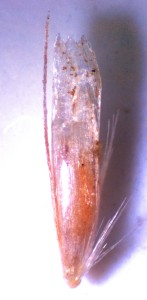Dr M has been posting Poaceae of late. His series on the Tribes of grasses features details of British grass genera including quite intimate details of the grass spikelet (as the Poaceae song says: the flowers are reduced to spikelets strange yet magical!).
But the beginning botanist might find this a touch overwhelming and Dr M can almost hear the cries: “Dr M! do we really need to dissect the grass spikelet to give a grass a name? Some of those spikelets are truly tiny! Give us a break Dr M! This is all more than a touch over-the-top is it not?”
 But Dr M responds: “I appreciate that getting to grips with details of the grass spikelet may seem advanced and more than a touch daunting, but trust Dr M when he says it is well worth the effort. The joy that can be had is boundless, for example when you carefully dismantle the little spikelet of Deschampsia cespitosa and discover the lemma with that telling dorsal awn! (Deschampsia = Tribe Aveneae – the dorsal awn tribe!).”
But Dr M responds: “I appreciate that getting to grips with details of the grass spikelet may seem advanced and more than a touch daunting, but trust Dr M when he says it is well worth the effort. The joy that can be had is boundless, for example when you carefully dismantle the little spikelet of Deschampsia cespitosa and discover the lemma with that telling dorsal awn! (Deschampsia = Tribe Aveneae – the dorsal awn tribe!).”
Dr M has always maintained that grass identification is not as tricky as some would have us believe and appreciates that dissecting spikelets may seem to be emphasising the trickiness of the group rather than the opposite! But Dr M is NOT proposing spikelet dissection for each and every time you encounter a grass to ID. BUT rather as a part of a growing appreciation of the grasses – a little spikelet dissection goes a long way to ensuring a solid foundation and lasting and loving relationship with grasses!
This video from Timothy M Jones (Louisiana State University Herbarium) is a great demonstration of how to dissect a grass spikelet to reveal the important features: upper and lower glumes, lemma, palea and caryopsis (the grass “seed”). Admittedly this is quite a large spikelet (what genus do you think?) and he uses a microscope which you might not have at home! But you only need a pair of fine forceps to get practicing with some of the larger spikelets on the kitchen table and you will soon find it possible to work with some of the smaller ones too!
